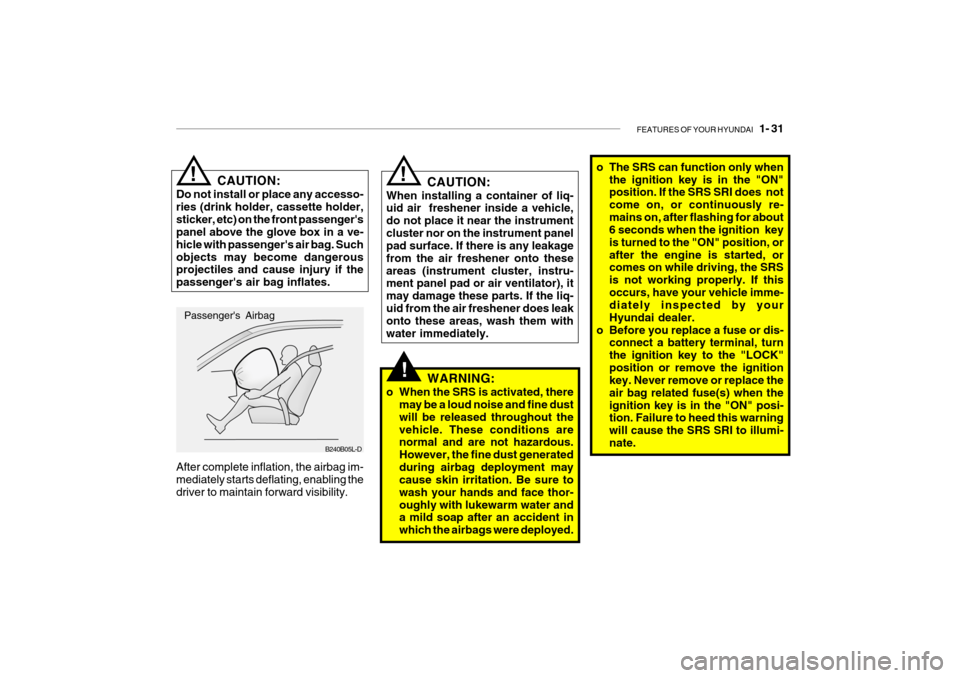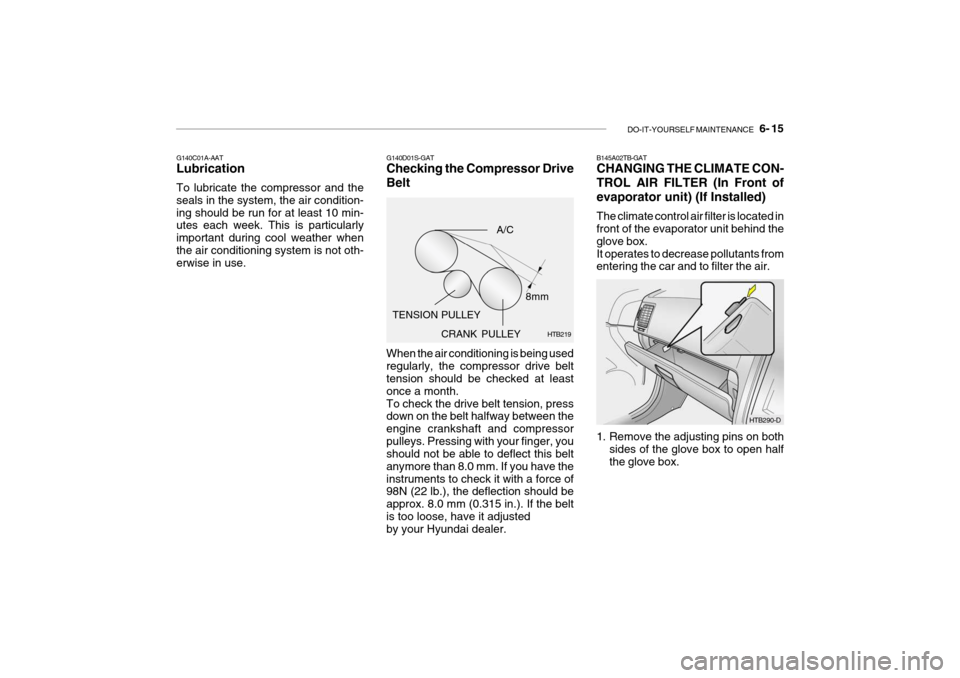2009 Hyundai Getz glove box
[x] Cancel search: glove boxPage 9 of 191

YOUR VEHICLE AT A GLANCE
F9
1. Glove Box
2. Passenger's Airbag (If installed)
3. Audio System (If installed)
4. Hazard Warning Light
5. Digital Clock
6. Windshield Wiper/Washer Switch
7. Horn and Driver's Airbag (If installed)
8. Instrument Cluster
9. Multi-Function Light Switch
10. Front Fog Light Switch (If installed)
11. Rear Drink Holder
CAUTION:
When installing a container of liquid air freshener inside a vehicle, do not place it near the instrument cluster nor on the instrument panel pad surface. If there is any leakage from the airfreshener onto these areas (instrument cluster, instrument panel pad or air ventilator), it may damage these parts. If the liquid from the air freshener does leak onto these areas, wash them with water immediately. 12. Hand Brake Lever
13. Shift Lever (If installed)
14. Front Drink Holder
15. Ashtray
16. Power Outlelet
17. Heating/Air Conditioning Control Panel
(If installed)
18. Audio Remote Control Switch (If installed)
19. Fuse Box
20. Bonnet Release Lever
!
Page 39 of 191

1- 28 FEATURES OF YOUR HYUNDAI
B240B01TB
Driver's Airbag
Your vehicle is equipped with a Supple- mental Restraint (Air Bag) System and lap/shoulder belts at both the driver andpassenger seating positions. The indi- cations of the system's presence are the letters "SRS AIR BAG" embossedon the airbag pad cover in the steering wheel and printed on the passenger's side front panel pad above the glovebox. B240A03TB-DAT SUPPLEMENTAL RESTRAINT (AIRBAG) SYSTEM (If Installed)
WARNING:
o As its name implies, the SRS is designed to work with, and be supplemental to, the driver's and the passenger's three point seat belt systems and is not a substi-tute for them. Therefore your seat belts must be worn at all times while the vehicle is in motion. Inaddition, the airbags deploy only in certain frontal impact condi- tions severe enough to likelycause significant injury to the vehicle occupants.
o The SRS is designed to deploy the airbags only when an impactis sufficiently severe and when the impact angle is less than 30°from the forward longitudinal axis of the vehicle and will not deploy in side, rear or rollover impacts.Additionally, the airbags will only deploy once. Thus, seat belts must be worn at all times.
The Hyundai SRS consists of airbags installed under the pad covers in the centre of the steering wheel and thepassenger's side front panel above the glove box. The purpose of the SRS is to provide the vehicle's driver and/or thefront passenger with additional protec- tion than that offered by the seat belt alone, in case of a frontal impact ofsufficient severity. NOTE: Be sure to read information about the SRS on the labels provided on the backside of the sun visor.
!
Page 41 of 191

1- 30 FEATURES OF YOUR HYUNDAI
The SRS service reminder indicator (SRI) on the instrument panel will blink for about 6 seconds after the ignitionkey is turned to the "ON" position or after the engine is started, after which the SRI should go out. The airbag modules are located both in the centre of the steering wheel and in the front passenger's panel above theglove box. When the SRSCM detects a considerable impact to the front of the vehicle, it will automatically deploy theairbags.
Passenger's Airbag
Upon deployment, tear seams molded directly into the pad covers will sepa- rate under pressure from the expan-sion of the airbags. Further opening of the covers then allows full inflation of the airbags. A fully inflated airbag in combination with a properly worn seat belt slowsthe driver's or the passenger's forward motion, thus reducing the risk of head or chest injury. HTB204-D
B240B02L-DB240B03L-D
Page 42 of 191

FEATURES OF YOUR HYUNDAI 1- 31
!
B240B05L-D o The SRS can function only when
the ignition key is in the "ON" position. If the SRS SRI does not come on, or continuously re-mains on, after flashing for about 6 seconds when the ignition key is turned to the "ON" position, orafter the engine is started, or comes on while driving, the SRS is not working properly. If thisoccurs, have your vehicle imme- diately inspected by your Hyundai dealer.
o Before you replace a fuse or dis- connect a battery terminal, turnthe ignition key to the "LOCK"position or remove the ignition key. Never remove or replace the air bag related fuse(s) when theignition key is in the "ON" posi- tion. Failure to heed this warning will cause the SRS SRI to illumi-nate.
CAUTION:
When installing a container of liq- uid air freshener inside a vehicle, do not place it near the instrumentcluster nor on the instrument panel pad surface. If there is any leakage from the air freshener onto theseareas (instrument cluster, instru- ment panel pad or air ventilator), it may damage these parts. If the liq-uid from the air freshener does leak onto these areas, wash them with water immediately.
!
WARNING:
o When the SRS is activated, there may be a loud noise and fine dust will be released throughout thevehicle. These conditions are normal and are not hazardous. However, the fine dust generatedduring airbag deployment may cause skin irritation. Be sure to wash your hands and face thor-oughly with lukewarm water and a mild soap after an accident in which the airbags were deployed.
After complete inflation, the airbag im-mediately starts deflating, enabling thedriver to maintain forward visibility. Passenger's Airbag!
CAUTION:
Do not install or place any accesso- ries (drink holder, cassette holder,sticker, etc) on the front passenger's panel above the glove box in a ve- hicle with passenger's air bag. Suchobjects may become dangerous projectiles and cause injury if the passenger's air bag inflates.
Page 68 of 191

FEATURES OF YOUR HYUNDAI 1- 57
Type B In the "DR" position, the interior cour- tesy light comes on when any door isopened regardless of the ignition key position. The light goes out gradually 6 seconds after the door is closed.
oON In the "ON" position, the light stays on at all times.
o OFF In the "OFF" position, the light stays off at all times even though a door is open.
!
!
WARNING:
To avoid the possibility of injury in case of an accident or a sudden stop, the glove box door should bekept closed when the car is in mo- tion.
o To open the glove box, pull on the glove box release lever.
B500A01A-AAT GLOVE BOX
HTB101-D
HTB102
B491A01TB-GAT SPECTACLE CASE (If Installed) The spectacle case is located on the driver side of roof trim.Pull the end of the cover to open the spectacle case.
WARNING:
Do not keep objects such as sharp or unsuitable things inside the spec- tacle case. Such objects can be thrown out in the event of a suddenstop or an accident, possibly injur- ing the passengers in the vehicle.
Page 90 of 191

FEATURES OF YOUR HYUNDAI 1- 79
B740D01A-AAT Operation Tips
o If the interior of the car is hot when
you first get in, open the windows for a few minutes to expel the hot air.
o When you are using the air condi-
tioning system, keep all windowsclosed to keep hot air out.
o When moving slowly, as in heavy
traffic, shift to a lower gear. Thisincreases engine speed, which in turn increases the speed of the air conditioning compressor.
o On steep grades, turn the air condi- tioning off to avoid the possibility ofthe engine over-heating.
o During winter months or in periods when the air conditioning is not usedregularly, run the air conditioningonce every month for a few min- utes. This will help circulate the lubricants and keep your system inpeak operating condition.
!
B760A01Y
The climate control air filter is located in front of the evaporator unit behind theglove box. It operates to decrease the amount of pollutants from entering the car.To replace the climate control air filter, refer to the page 6-15.
B760A04TB-DAT CLIMATE CONTROL AIR FILTER
(In Front of evaporator unit)(If Installed)
Inside of a vehicle
Evaporator core Filter
BlowerOutside air
Inside air CAUTION:
o Replace the filter every 15,000 km (10,000 miles) or once a year. If the car is being driven in severe conditions such as dusty, roughroads, more frequent climate con- trol air filter inspections and changes are required.
o When the air flow rate is sud- denly decreased, it must bechecked at an authorised dealer.
Page 135 of 191

5- 2 VEHICLE MAINTENANCE REQUIREMENTS
F010C01A-DAT
Specified Scheduled Proce- dures
These are the procedures such as
inspections, adjustments and replace- ments that are listed in the mainte- nance charts starting on page 5-4. These procedures must be performedat the intervals shown in the mainte- nance schedule to assure that your warranty remains in effect. Althoughit is strongly recommended that they be performed by the factory-trained or distributor-trained technicians atyour Hyundai dealer, these proce- dures may be performed at any quali- fied service facility. It is suggestedthat genuine Hyundai service parts be used for any required repairs or replacements. Other parts of equiva-lent quality such as engine oil, engine coolant, manual or auto transaxle oil, brake fluid and so on which are notsupplied by Hyundai Motor Company or its distributor may be used without affecting your warranty coverage butyou should always be sure these are equivalent
F010A01A-DAT
MAINTENANCE INTERVALS Service requirements
To ensure that you receive satisfying
operation from your Hyundai, certain maintenance procedures must be per- formed. Although careful design and engineering have reduced these to aminimum, those that are required are of the utmost importance.
It is your responsibility to have these
maintenance procedures performed to comply with the terms of the war-ranties covering your new Hyundai. The Service Passport supplied with your new vehicle provides further in-formation about these warranties. F010E02S-DAT
Do-It-Yourself Maintenance
See page (6-1 ~ 6-31).
F010D01A-DAT
General Checks
These are the regular checks youshould perform each time you drive your Hyundai or you fill the fuel tank. A list of these items will be found onpage 6-4. F010F02A-DAT
A Few Tips
Whenever you have your Hyundai serviced, keep copies of the servicerecords in your glovebox. This will help ensure that you have documen- tation when required. This is espe-cially important when an emergency service is not performed at an authorised Hyundai dealer.
F010B01A-AAT Maintenance Requirements The maintenance required for your Hyundai can be divided into three main areas:
o Specified scheduled procedures
o General checks
o Do-it-yourself maintenance to the quality of the original Hyundai
parts. Your Service Passport providesfurther information about your war-ranty coverage.
Page 157 of 191

DO-IT-YOURSELF MAINTENANCE 6- 15
CRANK PULLEY
G140C01A-AAT Lubrication To lubricate the compressor and the seals in the system, the air condition-ing should be run for at least 10 min- utes each week. This is particularly important during cool weather whenthe air conditioning system is not oth- erwise in use.
G140D01S-GAT Checking the Compressor Drive Belt
HTB219
A/C
TENSION PULLEY 8mm
When the air conditioning is being used regularly, the compressor drive belt tension should be checked at least once a month.To check the drive belt tension, press down on the belt halfway between the engine crankshaft and compressorpulleys. Pressing with your finger, you should not be able to deflect this belt anymore than 8.0 mm. If you have theinstruments to check it with a force of 98N (22 lb.), the deflection should be approx. 8.0 mm (0.315 in.). If the beltis too loose, have it adjusted by your Hyundai dealer. HTB290-D
B145A02TB-GAT CHANGING THE CLIMATE CON-
TROL AIR FILTER (In Front ofevaporator unit) (If Installed) The climate control air filter is located in front of the evaporator unit behind the glove box.It operates to decrease pollutants from entering the car and to filter the air.
1. Remove the adjusting pins on both
sides of the glove box to open half the glove box.